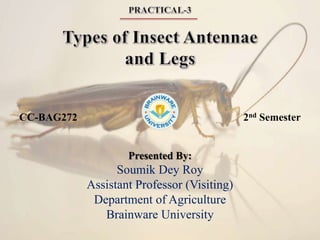
Practical 3: Types of Insect Antennae and Legs.pptx
- 1. CC-BAG272 2nd Semester Presented By: Soumik Dey Roy Assistant Professor (Visiting) Department of Agriculture Brainware University
- 3. General Structure of an Insect Antenna • Insect antennae are segmented appendages. •Antennae are generally borne on between and behind the two compound eyes. •Insects generally have one pair of antennae. •All insects except Protura have antennae. •A typical insect antenna constitutes of following segments ̶ i. Scape: first proximal segment which is connected with head sclerite. ii. Pedicel: second antennal segment. iii. Flagellum: third and longest segment of antenna. Flagellum is also many segmented. The sub-segments of flagellum are called Flagellomeres or Annuli.
- 4. Different Types of Insect Antennae
- 5. 1. Setaceous (Bristle like): Size of the segments decreases from base to apex. e.g. Leafhopper, Dragonfly, Damselfly. 2. Filiform (Thread like): Segments are usually cylindrical. Thickness of segments remains same throughout. e.g. Grasshopper. 3. Moniliform (Beaded): Segments are either globular or spherical with prominent constriction in between e.g. Termite. 4. Serrate (Saw like): Segments have short triangular projections on one side. e.g. Longicorn bettle. 5. Unipectinate (Comb like): Segments with long slender processes on one side. e.g. Sawfly.
- 6. 6. Bipectinate (Double comb like): Segments with long slender lateral processes on both the sides e.g. Silkworm moth. 7. Clavate (Clubbed): Antenna enlarges gradually towards the tip. e.g. Blister beetle. 8. Capitate (Knobbed): Terminal segments become enlarged suddenly. e.g. Butterfly. 9. Lamellate (Plate like): Antennal tip is expanded laterally on one side to form flat plates. e.g. Lamellicorn beetle. 10. Aristate: The terminal segment is enlarged. It bears a conspicuous dorsal bristle called arista. e.g. House fly.
- 7. 11. Stylate: Terminal segment bear a style like process. e.g. Horse fly, Robber fly. 12. Plumose (Feathery): Segments with long whorls of hairs e.g. Male mosquito. 13. Pilose (Hairy): Antenna is less feathery with few hairs at the junction of flagellomeres. e.g. Female mosquito. 14. Geniculate (Elbowed): Scape is long; remaining segments are small and are arranged at an angle to the first resembling an elbow joint. e.g. Ant, weevil and honey bee. 15. Flabellate (Fan like): Very small, third and subsequent segments with side processes giving a fan like arrangements. e.g. Strepsipterans/ stylopids, cedar beetles.
- 9. Coxa Trochanter Tarsus Tarsal Claw Pre-tarsus Tarsomer e General Structure of an Insect Leg • Insect legs are segmented appendages. •Legs are generally borne on both sides of the three thoracic segments (viz. prothorax, mesothorax and metathorax). •Insects have three pairs of leg. •A typical insect leg constitutes of following segments ̶ i. Coxa: first proximal leg segment which is connected with thoracic pleuron. ii. Trochanter: second leg segment b/w. coxa and femur. iii. Femur: third and stoutest segment of leg. iv. Tibia: fourth segment of leg which is usually long and provided with longitudinal spines. v. Tarsus: fifth segment of leg which is furthermore divided into 3-5 sub- segments termed as ‘tarsomeres’. vi. Pre-tarsus: the terminal segment of leg, comprises of tarsal claws and leg pads.
- 10. Different Types of Insect Legs
- 11. 2. Cursorial (Running Leg): Leg suited for running. Femur is not swollen. Legs are long and slender. Ex. All three pairs of legs of cockroach. 3. Saltatorial (Jumping Leg): Femur is swollen and provided with strong muscles for jumping. Trochanter is fused with femur. Ex. Hind legs of grasshopper. 1. Ambulatorial (Walking Leg): Simple type of leg, no modifications. Femur and tibia are long. Ex. Fore leg and middle legs of grasshopper. 4. Scansorial (Clinging Leg): Tibia is stout and modified into a thumb-like process, suited for clinging. Ex. All three pairs of legs of head louse. 5. Natatorial (Swimming Leg): Femur, tibia and first four tarsomeres are broad and flattened, provided with long hairs/setae. Legs are suited for swimming. Ex. Hind legs of water beetle.
- 12. 6. Fossorial (Digging Legs): Femur is stout, tibia and tarsus provided with strongly pointed tines. Leg suited for digging. Ex. Fore legs of mole cricket. 7. Raptorial (Grasping Leg): Coxae elongated. Femur stout and grooved, tibia fits inside the femoral groove. Both femur and tibia are provided with spines. Leg suited for capturing prey, no use in locomotion. Ex. Fore legs of Preying Mantis. 8. Foragial Leg: Fore and middle legs provided with long hairs for pollen collection. Hind tibia has a shallow cavity for storing pollen. It is known as ‘Pollen Basket’ or ‘Corbicula’. Ex. Legs of worker honeybees. 9. Sticking Leg: Pre-tarsus provided with a pair of pads/‘Pulvilli’ and a median spine like ‘empodium’. Legs suited for sticking to smooth surfaces. Ex. All three pairs of legs of housefly. 10. Prolegs or Abdominal Legs: 2-5 pairs of short, fleshy, non-segmented legs are found in the abdomen of caterpillars. Prolegs are provided with small circlets of hooks at the tip, known as ‘crochets’.
- 13. Thank You